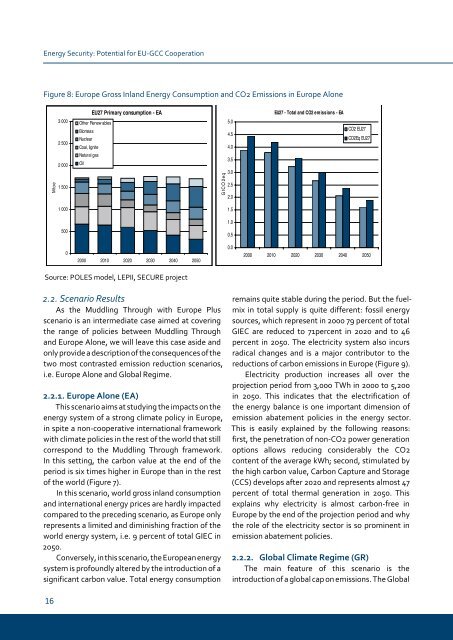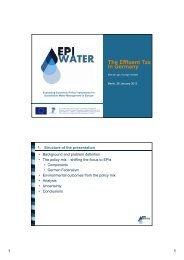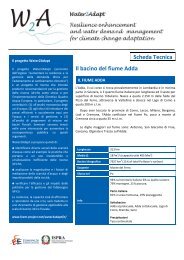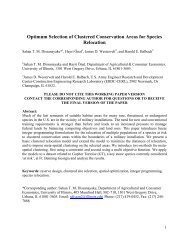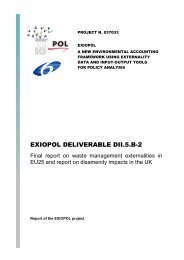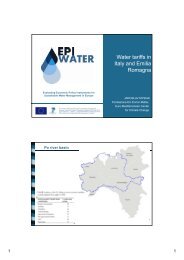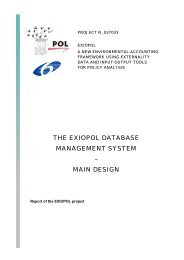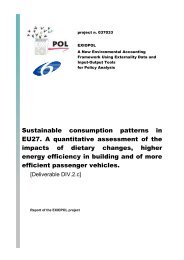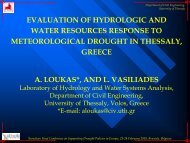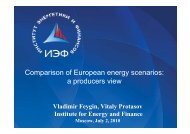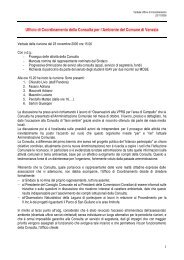Gulf and European Energy Supply Security - Feem-project.net
Gulf and European Energy Supply Security - Feem-project.net
Gulf and European Energy Supply Security - Feem-project.net
Create successful ePaper yourself
Turn your PDF publications into a flip-book with our unique Google optimized e-Paper software.
<strong>Energy</strong> <strong>Security</strong>: Potential for EU-GCC Cooperation<br />
Figure 8: Europe Gross Inl<strong>and</strong> <strong>Energy</strong> Consumption <strong>and</strong> CO2 Emissions in Europe Alone<br />
2.2. Scenario Results<br />
As the Muddling Through with Europe Plus<br />
scenario is an intermediate case aimed at covering<br />
the range of policies between Muddling Through<br />
<strong>and</strong> Europe Alone, we will leave this case aside <strong>and</strong><br />
only provide a description of the consequences of the<br />
two most contrasted emission reduction scenarios,<br />
i.e. Europe Alone <strong>and</strong> Global Regime.<br />
2.2.1. europe Alone (eA)<br />
This scenario aims at studying the impacts on the<br />
energy system of a strong climate policy in Europe,<br />
in spite a non-cooperative international framework<br />
with climate policies in the rest of the world that still<br />
correspond to the Muddling Through framework.<br />
In this setting, the carbon value at the end of the<br />
period is six times higher in Europe than in the rest<br />
of the world (Figure 7).<br />
In this scenario, world gross inl<strong>and</strong> consumption<br />
<strong>and</strong> international energy prices are hardly impacted<br />
compared to the preceding scenario, as Europe only<br />
represents a limited <strong>and</strong> diminishing fraction of the<br />
world energy system, i.e. 9 percent of total GIEC in<br />
2050.<br />
Conversely, in this scenario, the <strong>European</strong> energy<br />
system is profoundly altered by the introduction of a<br />
significant carbon value. Total energy consumption<br />
1<br />
e<br />
o<br />
t<br />
M<br />
3 000<br />
2 500<br />
2 000<br />
1 500<br />
1 000<br />
500<br />
0<br />
EU27 Primary consumption - EA<br />
Other Renew ables<br />
Biomass<br />
Nuclear<br />
Coal, lignite<br />
Natural gas<br />
Oil<br />
2000 2010 2020 2030 2040 2050<br />
Source: POLES model, LEPII, SECURE <strong>project</strong><br />
q<br />
e<br />
2<br />
O<br />
C<br />
t<br />
G<br />
5.0<br />
4.5<br />
4.0<br />
3.5<br />
3.0<br />
2.5<br />
2.0<br />
1.5<br />
1.0<br />
0.5<br />
0.0<br />
EU27 - Total <strong>and</strong> CO2 emissions - EA<br />
CO2 EU27<br />
CO2Eq EU27<br />
2000 2010 2020 2030 2040 2050<br />
remains quite stable during the period. But the fuelmix<br />
in total supply is quite different: fossil energy<br />
sources, which represent in 2000 79 percent of total<br />
GIEC are reduced to 71percent in 2020 <strong>and</strong> to 46<br />
percent in 2050. The electricity system also incurs<br />
radical changes <strong>and</strong> is a major contributor to the<br />
reductions of carbon emissions in Europe (Figure 9).<br />
Electricity production increases all over the<br />
<strong>project</strong>ion period from 3,000 TWh in 2000 to 5,200<br />
in 2050. This indicates that the electrification of<br />
the energy balance is one important dimension of<br />
emission abatement policies in the energy sector.<br />
This is easily explained by the following reasons:<br />
first, the pe<strong>net</strong>ration of non-CO2 power generation<br />
options allows reducing considerably the CO2<br />
content of the average kWh; second, stimulated by<br />
the high carbon value, Carbon Capture <strong>and</strong> Storage<br />
(CCS) develops after 2020 <strong>and</strong> represents almost 47<br />
percent of total thermal generation in 2050. This<br />
explains why electricity is almost carbon-free in<br />
Europe by the end of the <strong>project</strong>ion period <strong>and</strong> why<br />
the role of the electricity sector is so prominent in<br />
emission abatement policies.<br />
2.2.2. Global Climate Regime (GR)<br />
The main feature of this scenario is the<br />
introduction of a global cap on emissions. The Global


